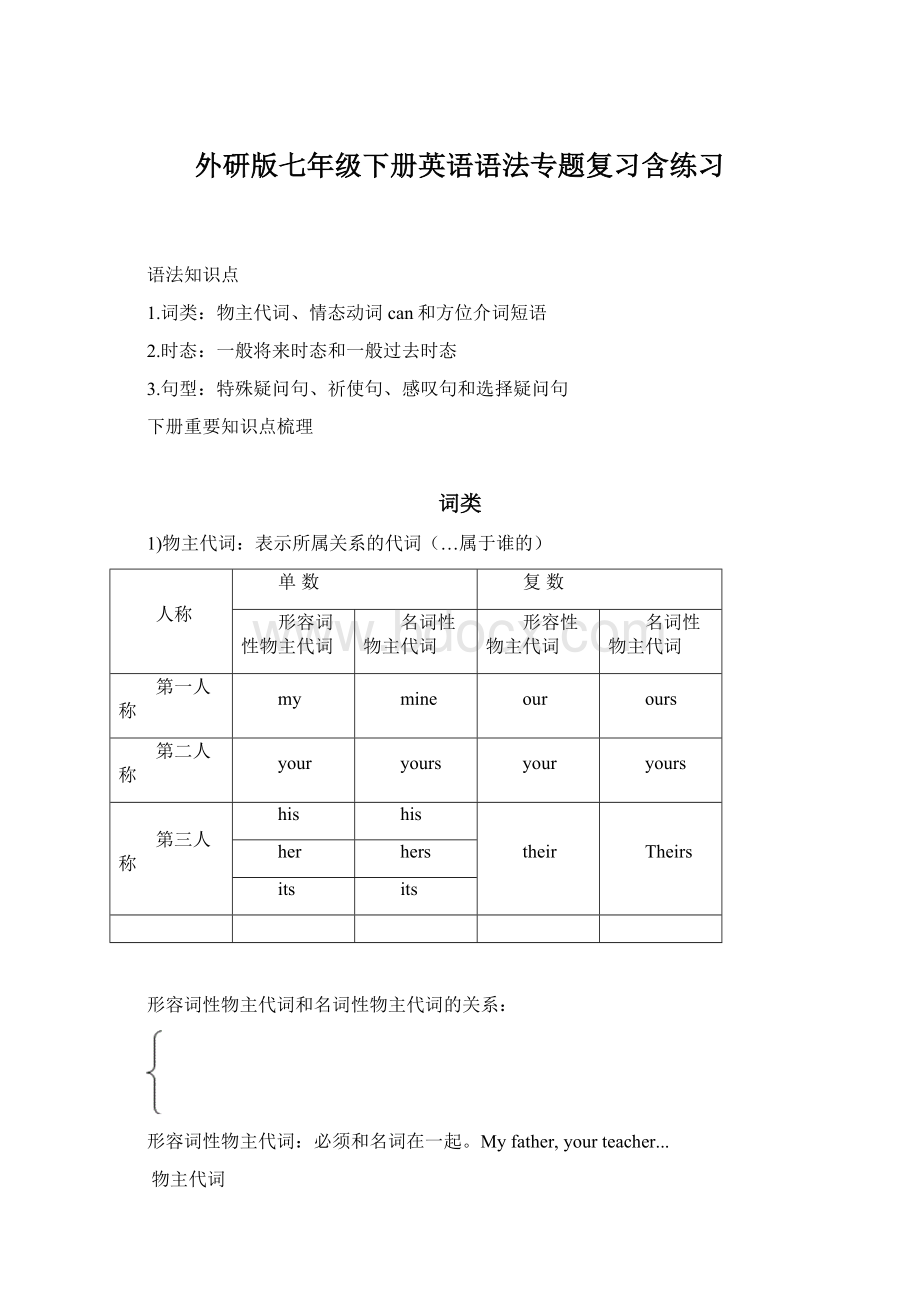外研版七年级下册英语语法专题复习含练习.docx
《外研版七年级下册英语语法专题复习含练习.docx》由会员分享,可在线阅读,更多相关《外研版七年级下册英语语法专题复习含练习.docx(13页珍藏版)》请在冰豆网上搜索。

外研版七年级下册英语语法专题复习含练习
语法知识点
1.词类:
物主代词、情态动词can和方位介词短语
2.时态:
一般将来时态和一般过去时态
3.句型:
特殊疑问句、祈使句、感叹句和选择疑问句
下册重要知识点梳理
词类
1)物主代词:
表示所属关系的代词(…属于谁的)
人称
单数
复数
形容词性物主代词
名词性物主代词
形容性物主代词
名词性物主代词
第一人称
my
mine
our
ours
第二人称
your
yours
your
yours
第三人称
his
his
their
Theirs
her
hers
its
its
形容词性物主代词和名词性物主代词的关系:
形容词性物主代词:
必须和名词在一起。
Myfather,yourteacher...
物主代词
名词性物主代词:
相当于与之相对应的形容词性物主代词+名词。
Thisshirtismine.=Thisismyshirt.
练习
(1)选择题。
()1.Lookat .A.himB.heC.his
()2.Idrive totheparkeveryday.A.theyB.theirC.them
()3. classroomisbig.A.weB.usC.Our
()4.Ilove .A.sheB.herC.hers
()5.Doyouknow ?
A.I B.myC.me
()6.Iam son.A.theyB.theirC.them
()7.Thisisnot_____desk..Mydeskisoverthere.A.I B.myC.me
()8.-Canyouspell_____name,Harry?
-Sorry.A.you B.yourC.yours
()9.TomandJackarebrothers.Thisis_____room.A.they B.themC.their
()10.Weareinthesameclass._____classroomisverynice.A.our B.myC.ours
()11.Mrs.Greenismyteacher.I’m_____student.A.heB.hisC.him
()12.That’sacat._____nameisMimi.A.It B.It’sC.Its
(2)用括号里的代词的适当形式填空
1,MrYangis_____(we)teacher.______(him)isfromBeijing._______(his)teaches______(our)English.
2,Look,thereisacat._______(they)isLily's.____(it)nameisMimi.
3,Let______(I)tell______(she)about_____(he)lifeatschool.
4,Thisis______(they)room.Whereis_____(our)?
5,Don'tusetheeraser.______is______(me).
6,Theladyunderthetreeis______(me)aunt._____(her)oftensingswith_____(she)husband
2)情态动词can
1.含义:
表达人或物的能力,能或会…
2.特点:
情态动词can没有人称和数的变化,之后要加动词原形。
3.否定形式:
cannot(正式用法)=can’t(口语)
4.句型结构:
肯定句:
主语+情态动词+动词原形+其他+。
She/Theycanswimwell.
否定句:
主语+情态动词+not+动词原形+其他+。
She/Theycannotswimwell.
一般疑问句:
情态动词+主语+动词原形+其他+?
Canshe/theyswimwell?
Yes,she/theycan./No,she/theycan’t.
特殊疑问句:
疑问词+情态动词+主语+动词原形+其他+?
Whycanshe/theyswimwell?
Whocanswimwell?
练习:
()1)Thesignonthewallmeansyoustayawayfromthebuilding.
A.mustB.can’tC.shouldn't
()2)Howmanybooksyouseeonthedesk?
A.mayB.canC.should
()3)---youseethesignoverthere?
---Sorry,Ican’t.A.CanB.Can’tC.Should
4. Icanrunfast.I________________fast.(否定句)
5. Hecanplaybasketballwell.(一般疑问句)_______he______basketballwell?
3)介词
over
正上方
on
ontheleftof...在左边
nextto/near在……附近,紧挨着
inthefrontof
在……里面的前面under...在...正下方
between...and...在两者之间
LinglingsitsbetweenTonyandDaming.玲玲坐在托尼和大明之间
among在三者或三者以上之间
MissLiisamonglotsofstudents.李老师在许多同学之间
注意:
介词短语常和be动词连用。
时态
1)一般将来时
时间状语:
in+一段时间;tomorrow;inthefuture;next+时间;this+时间(表示将来时间的状语)
﹙Ⅰ﹚be(is,am.are)goingto的用法。
含义:
计划,打算做某事
将来时句型结构:
一般将来时begoingto+动词原形
肯定句结构:
主语+begoingto+动词原形+其他.
否定句结构:
主语+benotgoingto+动词原形+其他.
一般疑问句:
be动词提前
Be+主语+goingto+动词原形+其他?
肯定回答:
Yes,主语+be.
否定回答:
No,主语+benot.
注意:
①表示计划到某地去,谓语动词go与going重复,一般只说begoingto+地点.
②e/go/arrive/leave等表示位置转移的动词可用于现在进行表将来。
Eg:
IamgoingtoLondonnextyear.
Sheisgoingtocheckheremail.
Look!
Thebusising.
﹙Ⅱ﹚由shall和will引导的一般将来时
含义:
将会…
特点:
助动词shall和will没有人称和数的变化,之后要加动词原形。
shall在一般将来时中,一般用于第一人称之后。
例如:
I/WeshallhaveanEnglishlesson.我们将有一节英语课。
否定形式:
shallnot=shan′twillnot=won′t
将来时句型结构:
肯定句:
主语+shall/will+do
否定句:
主语+shall/will+not+do(willnot可缩写成won’t)
一般疑问句:
shall/will+主语+do
特殊疑问句:
疑问词+shall/will+主语+do
2)一般过去时
1.一般过去时表示过去某个时间发生的动作或存在的状态,常和表示过去的时间状语连用。
一般过去时也表示过去经常或反复发生的动作。
2.标志性时间状语:
yesterday(昨天),lastweek(上周),lastmonth(上个月),lastyear(去年),twomonthsago(两个月前),thedaybeforeyesterday(前天),in1990(在1990年),inthosedays(在那些日子里)等表示过去的时间状语连用。
3.动词结构:
V-ed
动词过去式变化规则:
1.一般在动词末尾加-ed,如:
pull-pulled,cook-cooked
2.结尾是e加d,如:
taste-tasted
3.末尾是辅音字母加一个元音字母和一个辅音字母的重读闭音节,应双写末尾的辅音字母,再加-ed,如:
stop-stopped
4.以“辅音字母+y”结尾的,变y为i,再加-ed,如:
study-studied
5.不规则动词过去式:
lose(丢失) ----lost
make(制造) ----made
mean(意思) ----meant
meet(见) ----met
pay(付) ----paid
say(说) ----said
sell(卖) ----sold
send(送)----sent
sit(坐) ----sat
sleep(睡) ----slept
smell(嗅) ----smelt
spell(拼写) ----spelt
spend(度过) ----spent
stand(站) ----stood
teach(教) ----taught
tell(告诉) ----told
win(赢) ----won
think(想) ----thought
understand(理解) ----understood
begin(开始) ----began
blow(吹) ----blew
break(打破) ----broke
choose(选择) ----chose
do(做) ----did
draw(画) ----drew
drink(喝) ----drank
drive(驾驶) ----drove
eat(吃) ----ate
fall(落下) ----fell
fly(飞) ----flew
forget(忘) ----forgot
give(给) ----gave
go(去) ----went
grow(成长) ----grew
know(知道) ----knew
lie(躺) ----lay----lain
ring(按铃) ----rang
write(写) ----wrote
ride(骑) ----rode
see(看见)----saw
show(出示) ----showed
wake(弄醒) ----woke
sing(唱) ----s